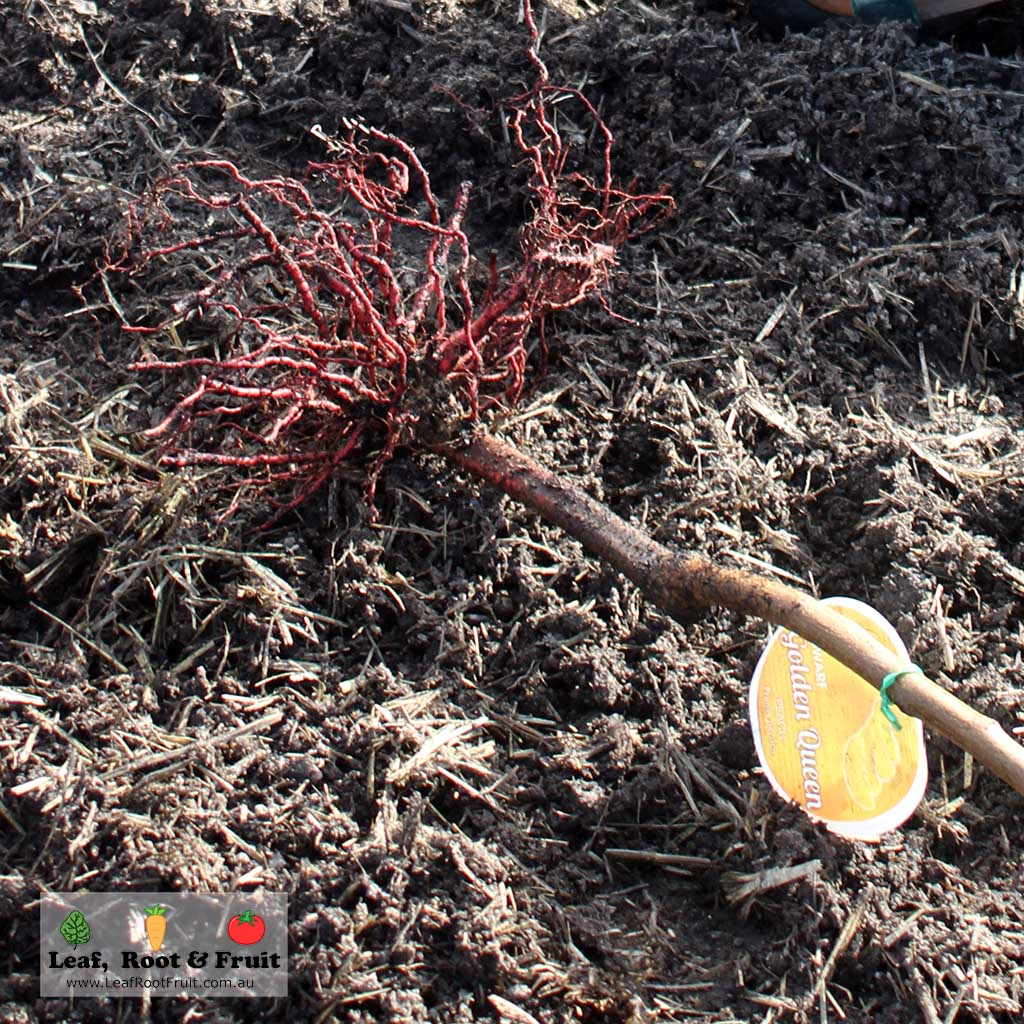
Most fruit trees available for purchase in nurseries, large hardware chains and online stores are grafted. This means that the desired tree has been added onto a rootstock, that can alter the growth habits of the tree.
For example, a small branch called a scion can be taken from a Granny Smith apple tree and can be grafted onto the roots of a different apple variety to dwarf the size of the Granny Smith tree to under two metres. Without being grafted onto dwarfing rootstocks, a Granny Smith apple tree grown from seed will grow to over 9 metres tall.
What is a rootstock?
A “rootstock” is the root system of a grafted tree. Rootstock trees are grown for one year, before a piece of scion (a small branch from the tree with the desired fruit qualities) is grafted onto the trunk of the rootstock. Once established, any remaining branches and foliage from the rootstock are removed so that only leaves from the scion are allowed to grow.
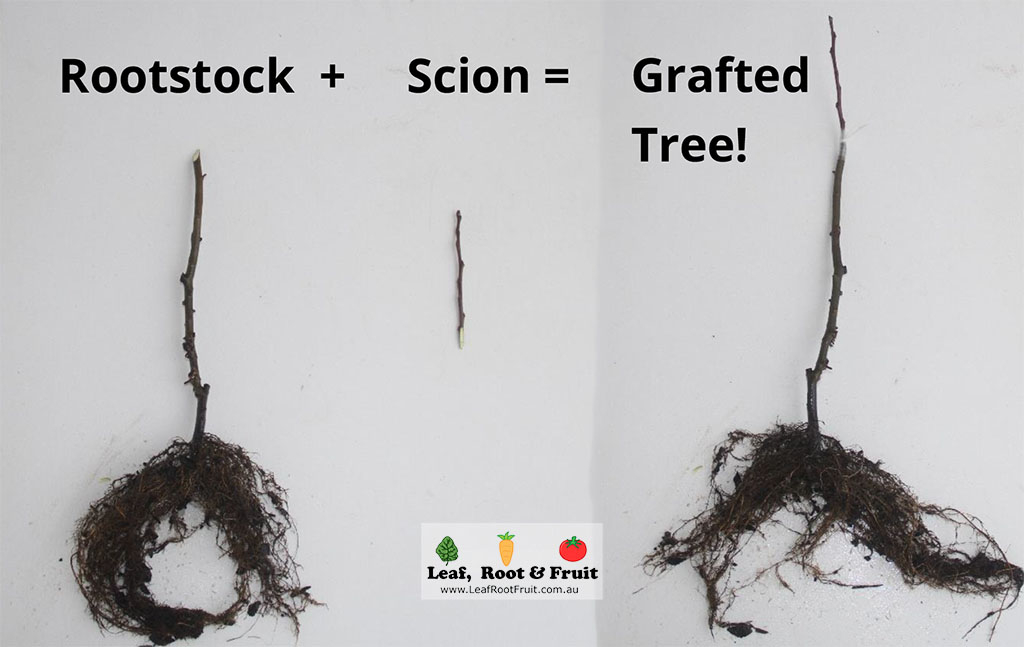
Often, if rootstocks grow into full sized trees without a scion grafted on top, they will bear poor quality fruit (if they fruit at all). However, the tree will probably be very hardy, and have good disease resistance.
You can use different rootstocks to control the following attributes of fruit trees:
- Tree size (or vigour).
- Time to fruiting (from the standard 5+ years, to as little as 2 years post grafting).
- The ability of the plant to survive in certain soil types or climatic conditions.
- The ability to tolerate wet (or very dry) soils.
- Disease resistance.
- Stability of the plant and ability to withstand strong winds.
- Hardiness of the plant.
Usually, the qualities of the fruit, such as taste, texture, colour and timing of ripening are determined by the scion.
By grafting fruit trees, with the right combinations of rootstocks and scions, you can have hardy, disease resistant trees that produce large quantities of tasty, quality fruit. Fruit Tree Pruning requirements will be minimal ensuring that your orchard thrives with little effort.
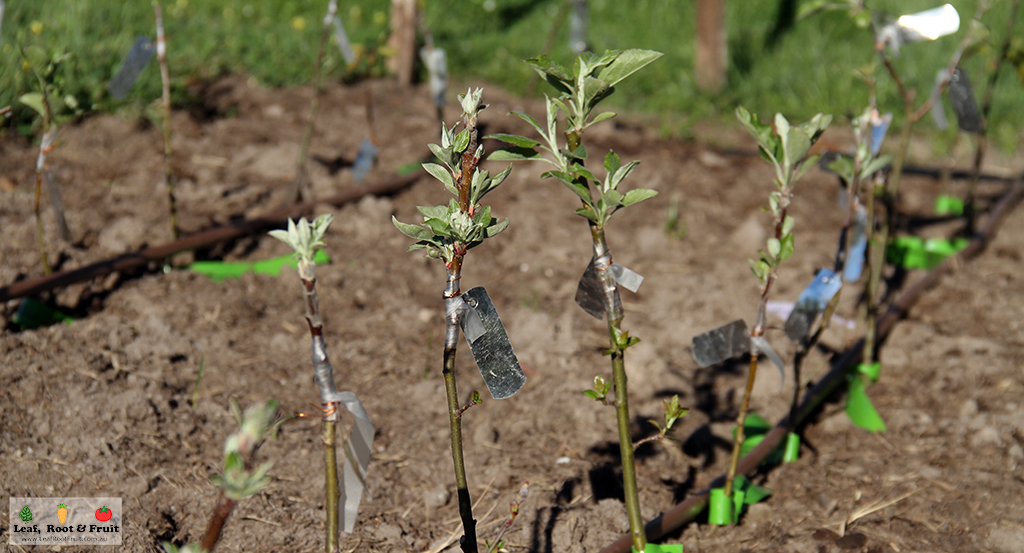
Don’t pick a fruit tree to plant into your garden based only on the type of fruit it will bear. Make sure you pay attention to the rootstock, as this controls many of the attributes of the fruit tree.
Duncan Cocking (Leaf, Root & Fruit) Tweet
Dwarf fruit tree rootstocks
Some dwarf fruit trees will thrive, while others won’t produce fruit if you restrict them to pots. It’s important to make sure you have the correct dwarfing rootstocks for your growing situation.
The development of dwarfing rootstocks for many different fruit trees, means that we can now grow very productive trees in much smaller spaces. There are a large range of different dwarf rootstocks and they all restrict tree height to various degrees.
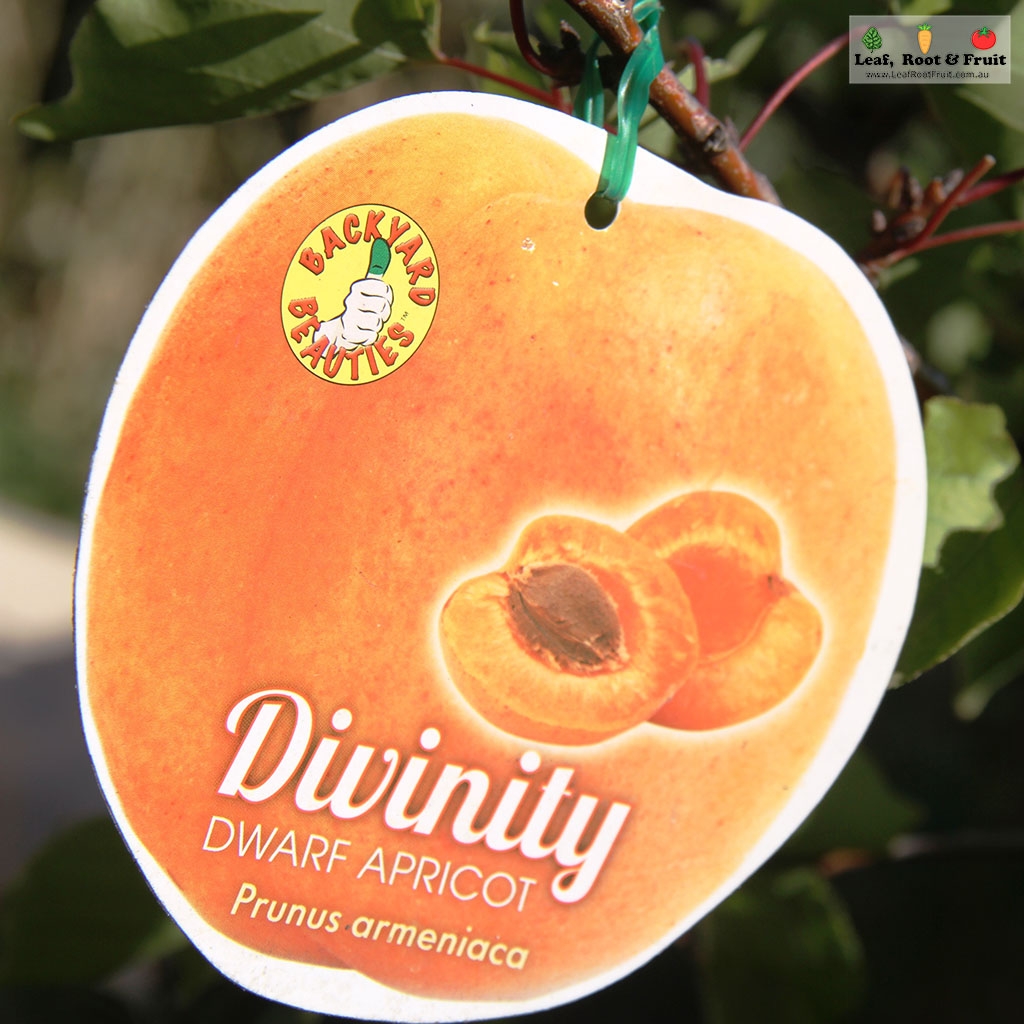
Fruit trees grafted onto dwarf rootstocks have many advantages over standard sized trees:
- They keep the fruit trees very small, so they can be grown in small spaces, espaliered along driveways, on balconies and grown in large containers.
- They hardly (if ever) require pruning because they don’t keep trying to grow into a 10 metre tall fruit tree.
- They often fruit within 2 years instead of the usual 7 to 10 years.
- You don’t need a ladder to pick the fruit.
- Netting to protect the fruit from possums and birds is much easier and more cost effective.
Not all dwarfing rootstocks are equal!
Some dwarfing rootstocks will restrict fruit tree growth to 1.5 metres, while other dwarf fruit trees may get as tall as five metres. It’s going to be difficult to pick the fruit from the top of your “dwarf” fruit tree if it’s five metres tall!
It is important to know exactly which dwarfing rootstock you are getting, so that you know how big the fruit tree will become. Often, this information is difficult to obtain from even your local nurseries. As a rule, I advise against buying fruit trees from the large hardware chains. They’re usually on rootstocks that are less than ideal and will mean that you’ll become a slave to their rampant growth habits.
Instead, I encourage that you buy your fruit trees from other suppliers that will provide you with the details about the different rootstocks their trees are grafted onto.
If you’re looking for grafted fruit trees to plant in Melbourne, some of the better suppliers are:
- Twin Hives Nursery (Monbulk, Vic)
- Ceres Nursery (Brunswick)
- Daleys Fruit Tree Nursery (Online, NSW)
- Yalca Fruit Trees (Online, Nathalia, Vic)
- Woodbridge Fruit Trees (Online, Tasmania)
Rootstock compatibility (and incompatibility)
There isn’t one rootstock to suit all varieties of fruit trees. The following image shows the different types of fruit trees that are usually compatible with each other. For example, all citrus types can usually be grafted onto the same type of rootstock (and each other).
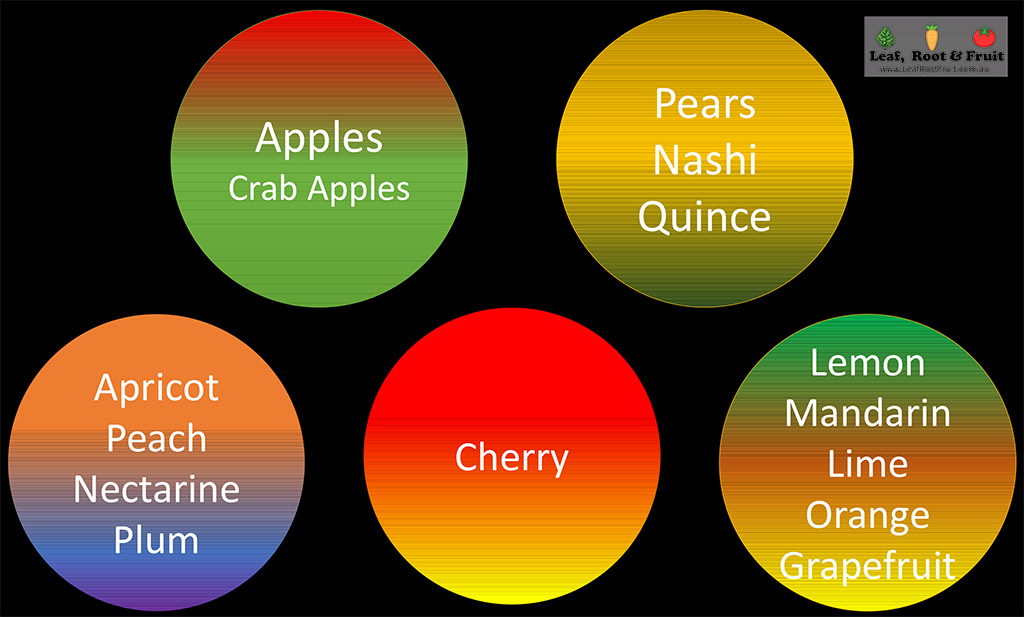
You can create ‘fruit salad trees’ by grafting different types of stone fruit onto the same tree. You could have a tree with four main branches, an apricot, a peach, a nectarine and a plum… all on the same tree!
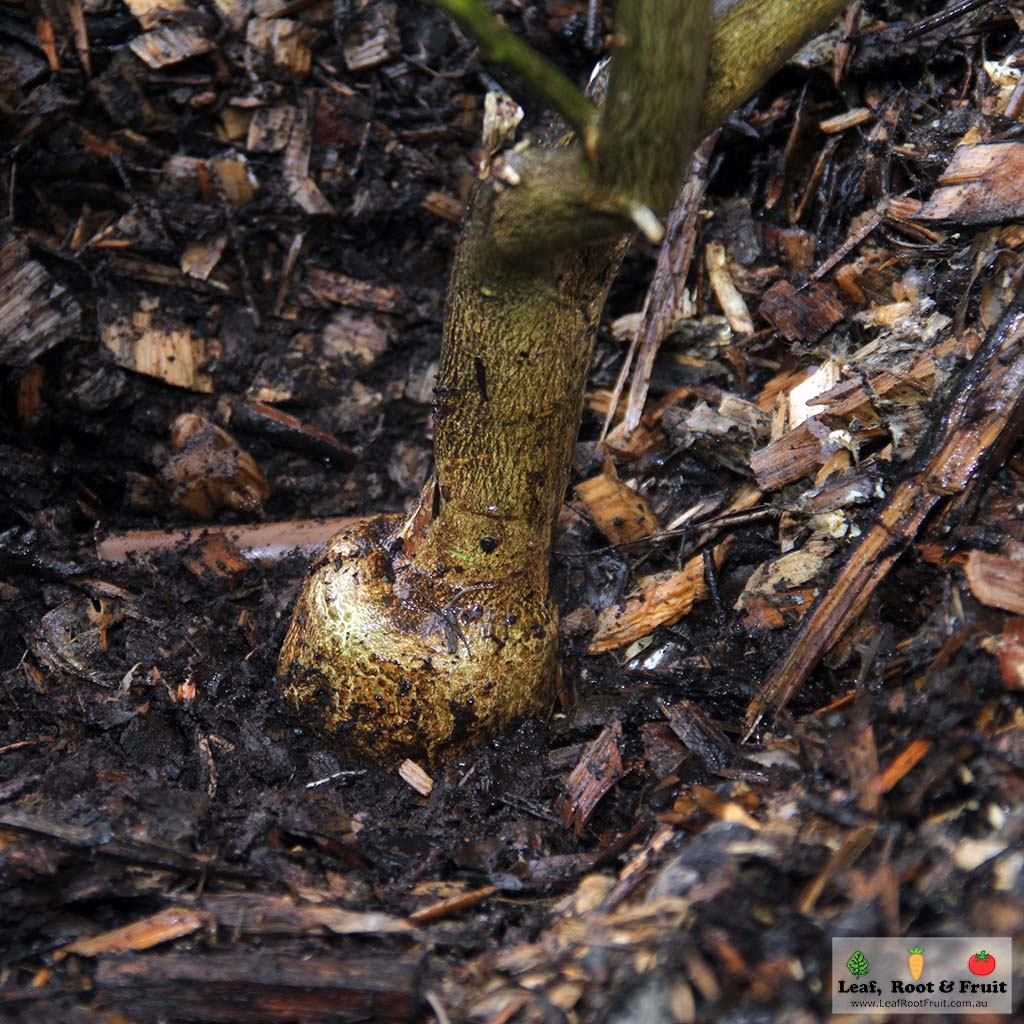
Some rootstocks also suffer from incompatibilities. For example, Imperial Mandarin has an incompatibility with trifoliata rootstock. This causes abnormal growth at the graft union. The tree will likely die from this incompatibility at around just fifteen years post grafting. Check out my guide to specific rootstocks for more examples of incompatibility and avoid buying a tree with a limited life-span.
Overcoming graft incompatibility with an interstem
Graft incompatibility can sometimes be overcome through the use of an interstem (also known as interstock) graft. For example, Quince A rootstock is a common rootstock for some pears. However, most varieties of pear are not compatible with the Quince A rootstock. A section of compatible pear scion around 10 to 20 cm long first needs to be grafted onto the Quince A and then the desired pear variety can be grafted on top of this.
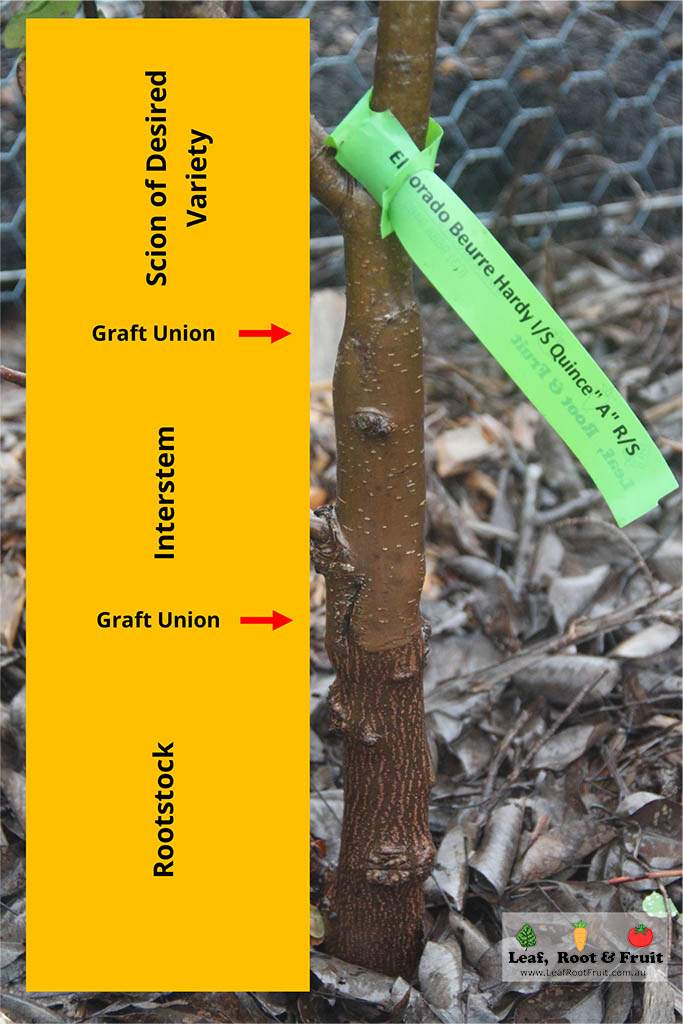
Which rootstock do I need for my situation?
The choice of rootstock really depends on your location, microclimate, soil type, what you are trying to grow, what size and shaped tree you want to grow. Are you espaliering the tree? Do you want a “step over?”
Is your area prone to high humidity at certain times of the year? Do you have good or poor drainage?
It’s difficult to generalise which is the best rootstock as there are so many variables. I’ve put together a list of the commonly available rootstocks to help you make the best informed decision possible. That being said, unless you are grafting your own trees, you may find it challenging to find fruit trees for sale that have been grafted onto the rootstock that you are after.
It is also worth mentioning that even though rootstocks have a big influence on the size of the tree, climatic conditions can also play a large role. Factors such as soil type, fertilizing regimes, irrigation, local climate conditions and even the vigour of the scion wood can all influence the size of the tree when it is mature.
Want to know more?
I have been designing, planting and maintaining backyard orchards for years. Here’s a list of fruit tree rootstocks that I consider for growing in various parts of Victoria.
Winter in Melbourne is the time to tend to our fruit trees. It is important to invest time and effort into fruit trees during winter, to ensure that you have successful fruit crops in summer. Take a look at my guide on caring for your fruit trees this winter.
If you would like further information on fruit trees, then please sign up to my Science of Edible Gardening Workshop Series. The May and June workshops (repeated annually) in the series focus heavily on orchard set up and management. I also run workshops on Backyard Orchard Set Up and Fruit Tree Grafting. See my upcoming events for more details on these.
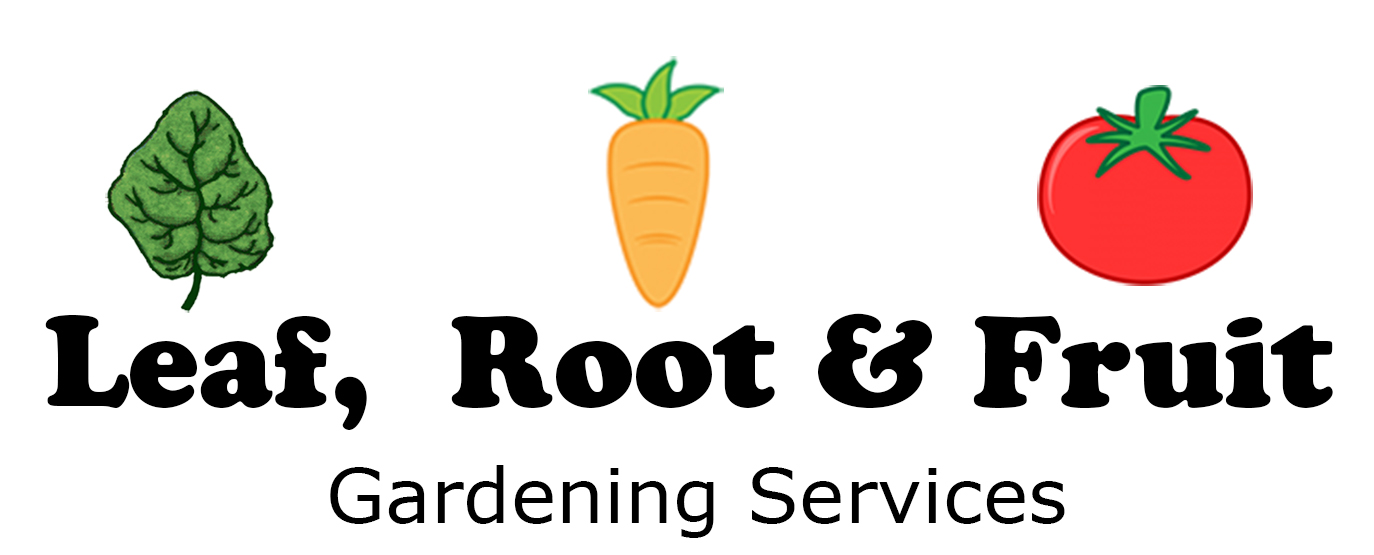

Thank you!!
Glad you found our blog post useful Alex. Good Luck and Happy Gardening
Thanks but I still don’t know what type of root stock I should choose fo example lemons. Or oranges.
Hi Bo,
Thanks for the feedback. It really depends on you location, microclimate, soil type, and what you are trying to grow, what size and shaped tree you want to grow etc. For Melbourne, we generally recommend citrus is grown on Trifoliata. However, there are compatibility issues with growing Imperial Mandarins and some lemons on this rootstock.
It’s impossible to generalise rootstock recommendations as each situation will be different.
Good Luck and Happy Gardening!
Duncan
Many thanks for your info
i do find it helpful and informative so thought i’d ask you further.
Which bare rooted trees dwarf- are good to put in now
grape? kiwi?;
i also have a dwarf pear that has never given fruit. i moved it last year but nothing-
should i move it again or re-pot with very rich soil?it is in my front garden on the side maybe planting to a bigger area
and should i take out an old rose tree and replace it with this dwarf pear?
The pear is now over 3-4 years i think so not sure what to do with it
many thanks
fay
Hi Fay,
There’s a lot of questions there, and without seeing the tree and the garden it is difficult for me to provide you with accurate advice.
The pears (even dwarf ones) can take a long time to fruit (up to 7+ years), even when in a pot. The type of potting ix will certainly have an influence on how well the tree thrives. Planting it into a larger area will result in the tee growing bigger, but will not necessarily speed up the time to fruiting.
You can certainly plant grapes and kiwi now. All the deciduous fruit trees are ideal for planting now.
Good Luck and Happy Gardening!
Duncan
Where can I buy the Trifoliata root stock, so I can graft my own lime tree before I move in a month? I am in south east Melbourne.
I found this article helpful and have signed up for your newsletter, thanks
Hi Ingrid,
It’s difficult to procure in small quantities. Most commercial growers sow the seeds and grow the rootstocks themselves. You may be better to buy an existing citrus from a nursery and graft your lime tree onto that.
Good Luck & Happy Gardening!
Duncan
Good afternoon, your site is most informative. I am completing renovations on a medium size deck where I would like to have 3 feature pots In a cluster, small medium and large which will be the feature on the deck. They will be facing west which I think will be suitable for dwarf fruit trees catching lots of sun. As I live on the Mornington Peninsula I will make my tree purchases from Diggers. My choice will be probably be 3 different citrus.
I have 2 questions – Is it too late to plant them now and what size pots would I purchase.
Thank you in anticipation
Lee
Hi Lee,
Citrus grow well in pots. I would aim to plant them in 50 to 60cm pots as a minimum, although they could be smaller pots for the first few years and subsequently potted up.
Most citrus are best planted when you would normally plant your tomato plants (Oct early Nov). Although potted trees could almost be potted up at any time.
Hope that helps
Duncan
I bought two orange trees from Aldi some years ago and checked the (just legible) labels recently after reading your warning that Aldi trees are likely to die. Both are actually on the Flying Dragon rootstock you recommend so your blanket condemnation is possibly overkill, especially seeing I was able to buy two trees for the normal price of one. Thank you for all your excellent gardening advice, especially your push back against “Prune in June” – I’ve always thought there must be a better way.
Regards, David.
Thank you for the best article I’ve read to date.
Thanks for the great feedback Eugienia!